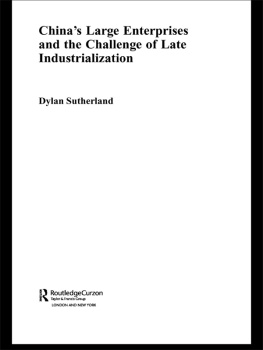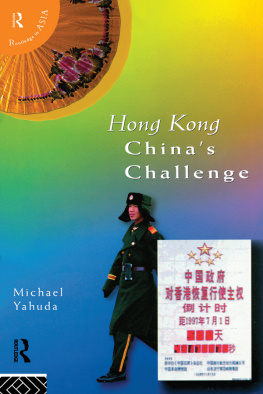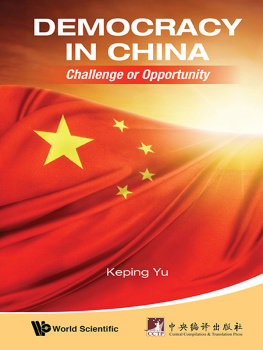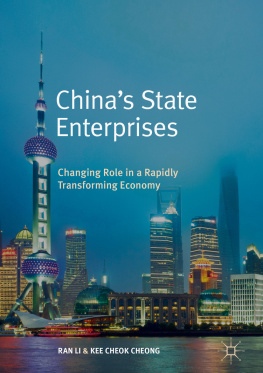Chinas Large Enterprises and the Challenge of Late Industrialization
This book considers the late industrialization of China, showing how government policies have encouraged the development of 120 national champions (akin to Japanese keiretsu and South Korean chaebol), how these national champions compete with multinational enterprises, and how Chinas rapid and successful late industrialization does not fit orthodox economic theories. The book provides a detailed illustration of these wider issues with a case study of the auto industry.
Dylan Sutherland is currently a member of the Faculty of Economics and Politics at Cambridge University. He is an assistant director of Development Studies at the university and a fellow of Wolfson College.
RoutledgeCurzon studies on the Chinese economy
Series editors
Peter Nolan, University of Cambridge
Dong Fureng, Beijing University
The aim of this series is to publish original, high-quality, research-level work by both new and established scholars in the West and the East, on all aspects of the Chinese economy, including studies of business and economic history.
- The Growth of Market Relations in Post-reform Rural China
A micro-analysis of peasants, migrants and peasant entrepreneurs
Hiroshi Sato
- The Chinese Coal Industry
An economic history
Elspeth Thomson
- Sustaining Chinas Economic Growth in the Twenty-First Century
Edited by Shujie Yao and Xianning Liu
- Chinas Poor Regions
Ruralurban migration, poverty, economic reform and urbanisation
Mei Zhang
- Chinas Large Enterprises and the Challenge of LateIndustrialization
Dylan Sutherland
Chinas Large Enterprises and the Challenge of Late Industrialization
Dylan Sutherland
First published 2003
by RoutledgeCurzon
11 New Fetter Lane, London EC4P 4EE
Simultaneously published in the USA and Canada
by RoutledgeCurzon
29 West 35th Street, New York, NY 10001
This edition published in the Taylor & Francis e-Library, 2003.
RoutledgeCurzon is an imprint of the Taylor & Francis Group
2003 Dylan Sutherland
All rights reserved. No part of this book may be reprinted or reproduced or utilized in any form or by any electronic, mechanical, or other means, now known or hereafter invented, including photocopying and recording, or in any information storage or retrieval system, without permission in writing from the publishers.
British Library Cataloguing in Publication Data
A catalogue record for this book is available from the British Library
Library of Congress Cataloging in Publication Data
A catalog record for this book has been requested
ISBN 0-203-51174-3 Master e-book ISBN
ISBN 0-203-34187-2 (Adobe eReader Format)
ISBN 0-415-30581-0 (Print edition)
Figures
Chinas large enterprises by province for various years
LME and SOE output share by various industrial sectors
Share of gross value of industrial output contributed by LMEs for forty Chinese industry sectors, 1987 and 1995
Province shares of national output by enterprise size for the auto industry, 1997
Tables
Share of large, medium and small enterprises in the gross value of industrial output
Average group assets, net assets, sales, taxes and exports by industrial sector, 1995
Industrial sectors of the first and second trial group batches
Evolution of policies and their implementation within the centrally approved enterprise groups, 198799
Description of Chinas national team players
Cross-border M&As with value over $1 billion, mega-deals, 19872000
Global assembly champions and strategic alliances (their acquisitions, equity partners)
Projections in first-tier supplier numbers, medium and long term
Global oligopoly in the auto component industry
Auto components enterprises, share (per cent) of various indicators in total components production
Provincial locations of Chinas preferred large-scale enterprises and groups in the late 1990s
Reported market shares for various products, business activities
Preface
This book is based around my PhD thesis. The research I undertook for the thesis was associated with the China Big Business Programme in the Judge Institute of Management Studies at Cambridge University, England. This programme brought together industry leaders from both China and the West and used a selection of case studies on some of Chinas leading firms to expose the major issues in the emergence of big business in China today.
At the very start of my research, the objective was to contribute to these case studies. My plan was to carry out a detailed investigation on the auto industry in China. Shortly after starting though, I became interested in another area of Chinas reforms. In the mid-1990s, short press reports in the Chinese media were beginning to mention Chinas plans to develop a batch of large enterprise groups, dubbed the national team. The trickles soon grew to a steady flow. These snippets of information drew my attention away from the more specialized area of the auto industry and a curiosity in the broader topic of the national team developed.
Initially, I searched through the Western media and academic press but could find little of substance on Chinas plans to build the national team groups. What seemed like a central component of their industrial policy remained a frustrating mystery. Given the earlier successes of enterprise groups in Japan and South Korea it seemed particularly strange that Chinas efforts had attracted so little attention. The increasingly obvious intentions of the Chinese government to attempt to emulate their East Asian neighbours (through what became known as the grasping the large, letting go of the small policy) made this omission all the more curious.
For the first year of my research, based in the United Kingdom, most of my insights into the large groups of the national team remained limited. By the late 1990s, however, a few academic articles began to hint at the increasingly important role of the large-scale sector in Chinas late industrialization. These findings contrasted sharply with mainstream opinion which had argued, even until the late 1990s, that there was little future for Chinas incumbent large enterprises. I became even more convinced that the national team really was important that an understanding of this select group of companies might also contribute towards the debate on the large-scale sector, as well as to far broader questions related to economics and development.
By the middle of 1998 it had become clear that little could be achieved without undertaking further research in China. News that the original batch of fifty-seven groups in the national team had been increased to 120 signified that the plans to develop groups were progressing quickly. To try and find out more I spent a year in China, carrying out both research on the auto industry (in accordance with the original plan), as well as on the enigmatic national team. It soon became clear that although relatively little was known in the West, the subject of large groups had become extremely topical in China.













